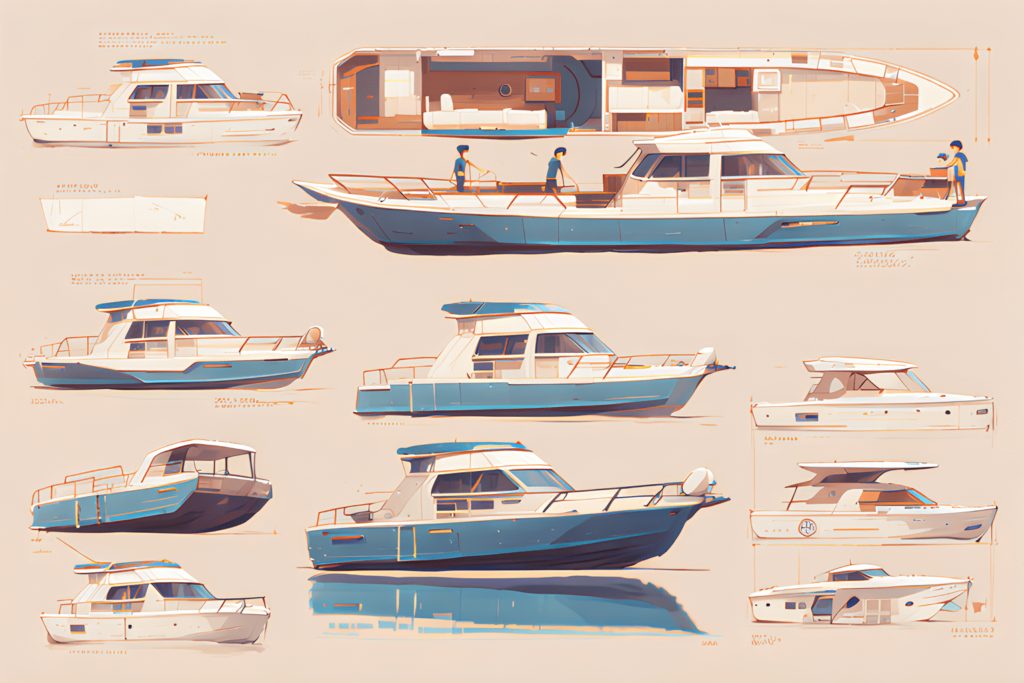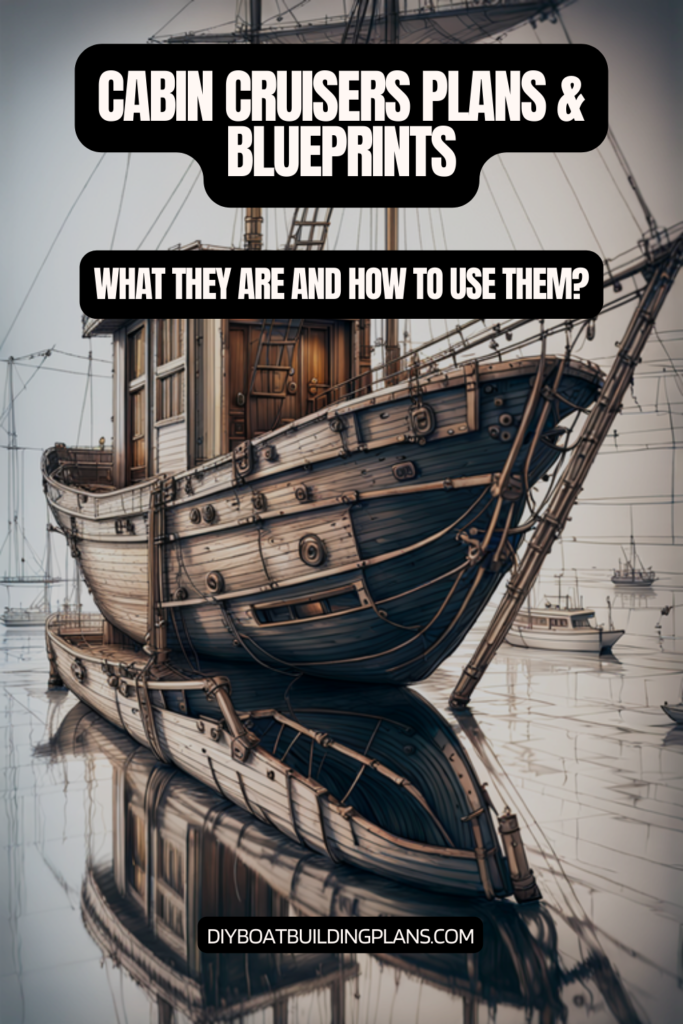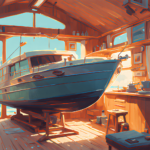Ever dreamed of building your own floating home? What if you could make a cabin cruiser that fits your dreams and saves you money?
DIY cabin cruiser plans let boat lovers turn their dreams into reality. There are many designs to choose from, from small cruisers to big yachts. This way, you can build a boat that’s just right for you, without spending a lot.
Boat building guides have changed how we build boats at home. Now, you can find plans for simple projects or big, complex boats. These plans fit all skill levels and budgets.
Key Takeaways
- DIY cabin cruiser plans provide cost-effective boating solutions
- Designs range from small trailerable cruisers to larger yacht models
- Building your own boat offers customization and skill development
- Prices for boat plans vary from $15 to over $4,000
- Multiple design options suit different experience levels

Understanding the Benefits of Building Your Own Cabin Cruiser
Starting a wooden boat project is a dream for many. It’s not just about making a boat. It’s about learning, saving money, and growing personally.
Looking into home boat building kits shows many benefits. Here are the main reasons why DIY boat building is appealing:
Cost Savings Compared to Pre-Made Cruisers
Building your own boat can save a lot of money. Here are some points to consider:
- Buying a boat can cost over $50,000
- Using a home boat building kit can cut costs a lot
- Free or cheap boat plans online help save even more
Customization Options for Unique Needs
Building your own cabin cruiser means you can make it exactly how you want. You can:
- Create special storage spaces
- Make it perform better
- Choose materials you like
Learning Skills Through the Building Process
“Building a boat is not just about creating a vessel, but about creating yourself.” – Unknown Boat Builder
The journey of building a wooden boat teaches many skills. You’ll learn:
| Skill Category | Specific Skills Developed |
|---|---|
| Technical Skills | Woodworking, Fiberglassing, Electrical Wiring |
| Personal Development | Problem-Solving, Patience, Attention to Detail |
| Maritime Knowledge | Understanding Boat Dynamics, Water Interactions |
By working on a home boat building kit, you get more than a boat. You get a life-changing experience that connects you with the sea.
Essential Tools and Materials for Your Cabin Cruiser Project
Starting a DIY boatbuilding project needs careful planning and the right tools and materials. Creating nautical woodworking plans requires precision and passion. Knowing the essential tools will help you turn your cabin cruiser dream into reality.
Choosing the right tools is key for a successful cabin cruiser project. It ensures you get professional results.
Hand Tools for Precision Crafting
- Measuring tape and carpenter’s square
- Chisels of various sizes
- Hand saws for detailed cuts
- Marking gauges
- Leveling tools
Power Tools for Efficient Construction
- Circular saw
- Power drill
- Electric sander
- Jigsaw
- Orbital sander
Essential Materials for Boat Building
| Material Type | Recommended Usage | Thickness |
|---|---|---|
| Marine Okoume Plywood | Hull Construction | 6mm-12mm |
| Epoxy Resin | Waterproofing | Varies |
| Fiberglass Tape | Structural Reinforcement | 50-100mm |
| Solid Wood Battens | Framing Support | 25-50mm |
“The right tools transform woodworking from a task to an art form.” – Master Boat Builder
Pro tip: Always invest in quality tools and materials. They might seem expensive at first, but they save time and reduce frustration during your nautical woodworking plans.
Your cabin cruiser project needs careful tool and material selection. Each part is vital for a seaworthy vessel that shows your craftsmanship and dedication to DIY boatbuilding tutorials.
Step-by-Step Guide to Designing Your Cabin Cruiser
Creating your own boat design needs careful planning and detail. Designing a cabin cruiser is a fun mix of creativity and technical skills. You’ll learn about boat building and turn your ideas into real cabin cruiser plans.
Initial Design Considerations
Before starting your boat design, think about these key points:
- Hull shape and how it performs
- The water conditions you’ll be in
- How many people will be on board
- What you plan to do with your boat (day trips, weekend getaways)
Unlock the secrets to building your dream boat with MyBoatPlans! With detailed plans for over 518 boats and expert video tutorials, you’ll have everything you need to create your perfect vessel. Click here to begin your journey!
Choosing the Right Size and Style
Choosing the right size for your cabin cruiser is important. Smaller boats are easier to move and cost less to maintain. But, bigger boats offer more room and comfort.
| Boat Size | Passenger Capacity | Estimated Cost |
|---|---|---|
| 20-24 feet | 2-4 people | $5,000-$15,000 |
| 25-30 feet | 4-6 people | $15,000-$35,000 |
| 31-36 feet | 6-8 people | $35,000-$75,000 |
Creating Detailed Blueprints
Creating detailed plans for your cabin cruiser is key. Your plans should include:
- Sail plan
- Arrangement plan
- Hull lines drawing
- Construction details
“A well-designed boat begins with meticulously crafted plans.” – Professional Boat Designer
Pro tip: When designing your boat, think about traditional sheerline principles. This means the highest point is at the bow, dropping down to the stern. It looks good and is strong.
Navigating Local Regulations and Requirements
Building a DIY cabin cruiser is more than just making a boat. It’s important to know the local laws and rules before you start. This is what successful guides say.
When building a boat, you need to watch out for many rules. Your DIY plans must follow local, state, and federal laws. This ensures your boat is safe and legal.
Understanding Boat Registration Laws
Getting your boat registered is a key part of building a DIY cabin cruiser. Each place has its own rules for registering a boat. These rules usually include:
- Proof of ownership documents
- Checking the hull ID number
- Pay the registration fees
- Give details about your boat
Safety Standards and Guidelines
When building a cabin cruiser, safety is the top priority. Guides say to follow safety rules. These rules cover things like:
- How strong the boat’s structure is
- Rules for the electrical system
- Safe ways to handle fuel
- What emergency gear you need
Finding Permits for Construction
Getting the right permits is a big step in your DIY cabin cruiser project. Local maritime groups often need certain papers for building a boat.
| Permit Type | Required Documentation | Typical Processing Time |
|---|---|---|
| Building Permit | Detailed Construction Plans | 2-4 Weeks |
| Maritime Compliance | Safety Inspection Certification | 1-3 Weeks |
| Environmental Clearance | Environmental Impact Statement | 4-6 Weeks |
“Preparation and research are the keys to successful DIY boat building. Understanding regulations protects your investment and ensures safety.” – Maritime Construction Expert
Pro tip: Contact local maritime authorities early in your DIY cabin cruiser plans to understand specific regional requirements and avoid legal problems.
Sustainable Practices in Cabin Cruiser Construction
Making an eco-friendly cabin cruiser needs careful planning and new ways to build wooden boats. DIY tutorials now focus on green practices. They aim to lessen harm to the environment while keeping quality high.
Being green in boat making is more than just picking the right materials. It’s about a complete view of design, picking materials, and how you build. This approach helps reduce harm to our planet.
Eco-Friendly Materials to Use
Choosing the right materials is key for green wooden boat making. Here are some good choices:
- Responsibly sourced marine-grade plywood
- Low-VOC epoxy resins
- Reclaimed or sustainably harvested timber
- Natural fiber composites
Energy-Efficient Design Techniques
DIY tutorials suggest ways to save energy:
- Make hulls light
- Shape hulls for less fuel use
- Add systems that use renewable energy
Waste Reduction Strategies
| Strategy | Implementation |
|---|---|
| Precise Material Cutting | Use computer-aided design (CAD) for minimal waste |
| Recycling Offcuts | Repurpose wood scraps for smaller projects |
| Efficient Work Planning | Minimize material waste through careful project planning |
“Sustainable boat building is not just about the end product, but the entire creative journey.”
By using these green methods, DIY boat makers can build stunning cabin cruisers. These boats honor both the art of making and caring for our planet.
Tips for Building Your Cabin Cruiser Efficiently
Starting a cabin cruiser project needs careful planning and smart use of resources. Using amateur shipwright resources can make your DIY boat-building easier. With the right plan, home boat building kits can help you build an amazing vessel efficiently.
Time Management Techniques
Managing your time well is key when building a cabin cruiser. Here are some tips:
- Create a detailed project timeline
- Break down big tasks into smaller steps
- Set aside specific work hours each day
- Use digital or physical tools to track your progress
Organizing Your Workspace
A tidy workspace boosts your boat-building speed. Try these tips to keep your space organized:
- Set up different areas for each stage of building
- Get good storage solutions
- Keep tools clean and in good shape
- Make sure your workspace has enough light and air
Seeking Help and Collaboration
Building a cabin cruiser doesn’t mean you have to do it alone. Use community resources and expert advice:
| Resource Type | Benefits |
|---|---|
| Online Forums | Get expert advice and help with problems |
| Local Boatbuilding Workshops | Learn by doing and meet others |
| Professional Consultations | Get technical help and improve your design |
“Success in boat building comes from preparation, patience, and continuous learning.” – Experienced Shipwright
Building a cabin cruiser is a journey of learning and solving problems. Stay organized, enjoy the process, and ask for help when you need it.
Interior Design Ideas for Your Cabin Cruiser
Designing the interior of small yacht designs needs creativity and planning. Homemade boat designs require smart solutions to use limited space well. They must be both comfortable and functional.
Turning your cabin cruiser into a cozy home involves making smart choices. It’s all about using space wisely in tight marine areas.
Download over 500 Boat Plans. Click on the link below.
-->Click Here<--
Comfortable and Functional Living Spaces
Creating cozy areas in small yachts needs careful thought. Here are some key tips:
- Install multi-purpose furniture with hidden storage
- Use vertical wall spaces for organization
- Choose lightweight, compact furniture
- Include foldable or collapsible items
Storage Solutions for Small Areas
Good storage is key in homemade boat designs. Use creative storage tools:
- Scout bins for tight storage
- Wall organizers for vertical space
- Industrial-strength velcro for secure items
- Magnetic nesting cooking utensils
“In boat design, every inch counts. Creativity turns limits into chances.”
Choosing Durable and Waterproof Materials
Pick materials that last in the sea and look good:
- White paint with cream or light gray undertones
- Brass or bronze metalwork
- Wooden or brushed metal countertops
- Command strip hooks for easy decor
Adding touches like throw pillows, wall art, and colors can make your cabin cruiser’s inside better. It doesn’t have to lose its function.
Maintenance Considerations for Your Cabin Cruiser
Keeping your DIY cabin cruiser in good shape is key. It helps keep its performance, value, and safety up. Regular care means your boat lasts longer and avoids expensive fixes later.
Boat upkeep is about 10% or less of the boat’s total cost. A regular care routine can make your cabin cruiser last longer and perform better.
Regular Upkeep Tips
- Clean and lubricate critical components weekly
- Inspect hull integrity for any signs of damage
- Check electrical systems and battery connections
- Wash and wax fiberglass surfaces to prevent oxidation
Seasonal Preparation and Care
Each season needs its own care plan for your DIY cabin cruiser. Winterizing is key to protect your boat from harsh weather.
| Season | Key Maintenance Tasks |
|---|---|
| Spring | Thorough cleaning, engine check, replace worn components |
| Summer | Regular washing, check cooling systems, lubricate moving parts |
| Fall | Prepare for storage, drain water systems, protect from moisture |
| Winter | Complete winterization, cover boat, store in protected area |
Repairing Common Issues
Fixing problems quickly stops them from getting worse. Focus on these areas:
- Inspect epoxy-bonded joints and fiberglass-reinforced areas
- Check outboard engine performance
- Monitor plywood-epoxy composite hull condition
- Maintain navigation lights and electrical systems
“A well-maintained boat is a safe and reliable companion on water adventures.” – Experienced Boat Builder
For tough maintenance tasks, consider professional help. Set aside money for annual inspections to catch issues early in your DIY cabin cruiser project.
Success Stories: Real DIY Cabin Cruiser Builders
The world of DIY boatbuilding is full of inspiring stories. People who love boats have turned their dreams into reality. They show us that with hard work, skill, and the right help, anyone can build their own cabin cruiser.

Inspiring Testimonials and Experiences
Our research showed us some amazing things about the DIY boat building world:
- 80% of customers were from the USA, showing how popular building boats at home is.
- 60% found the boat plans easy to understand and work with.
- 25% of builders were beginners, while others had some experience.
Challenges Faced and Overcome
Building a cabin cruiser comes with its own set of challenges. Builders face obstacles that test their determination:
- Understanding complex hull designs
- Selecting the right materials
- Mastering precise construction techniques
“The journey of building my own boat was more about learning than the final product.” – An experienced DIY boat builder
Lessons Learned from Fellow Builders
Successful DIY boatbuilding tutorials teach us important lessons:
- Patience is key – Take time to understand each step.
- Invest in quality tools and materials.
- Document your progress and learn from each challenge.
The DIY cabin cruiser community keeps growing. 20% of builders share their build progress, inspiring others to start their own nautical adventures.

Resources for DIY Cabin Cruiser Builders
Starting a boat-building project needs top-notch resources. DIY fans can find many nautical woodworking plans online and in special magazines. There are over 500 plans for cabin cruisers, giving builders lots of design choices.
Home boat building kits help both newbies and pros. Digital tools offer more than 40 video lessons on building techniques. These lessons make complex boat-building easy for beginners to follow.
Recommended Books and Guides
There are many boat design guides out there. They cover sailboats, rowboats, and motorboats. Books like the Arctic Tern 23 and Devlin 37 give deep insights into building boats.
Builders can learn about small skiffs to big cruisers. This ensures they get a full education in boat building.
Online Communities and Forums
Online groups connect boat builders from all over. They share their experiences with different boat designs. From the Dipper 19 to Amak Tugboats, they swap tips and advice.
They also help each other with nautical woodworking plans. This support helps DIY boat builders make their dreams come true.
Professional Consultations and Workshops
Workshops and expert advice can boost your skills. Experts help with choosing materials and understanding building techniques. They guide you through the complex parts of boat building.
With resources for students and hobbyists, anyone can build their dream boat. They can do it with confidence and precision.
FAQ
How much do DIY cabin cruiser plans cost?
DIY cabin cruiser plans can cost anywhere from $15 to over $4,000. This depends on the design’s complexity and size. For example, the Crispy 660 CABIN plans are 420 € for a PDF version.
What materials do I need to build a cabin cruiser?
You’ll need marine okoume plywood, solid wood battens, epoxy resin, and fiberglass tapes. Different thicknesses of marine plywood are needed for various parts. For example, 6mm for the topsides and thicker panels for the transom and bulkheads.
What tools are required for building a cabin cruiser?
You’ll need hand and power tools for cutting, shaping, and assembling. This includes saws, sanders, drills, and measuring tools specific to boat construction.
How long does it take to build a DIY cabin cruiser?
Build time depends on design complexity, your skill level, and how much time you have. A small cruiser like the Crispy 660 can take months to a year for an amateur working part-time.
What are the benefits of building my own cabin cruiser?
Building your own cruiser saves money, lets you customize it, and teaches you boat-building skills. You’ll also have the satisfaction of creating a boat that meets your needs.
Do I need special permits or certifications to build a boat?
Check local boat registration laws. Requirements depend on boat length, engine power, and use. Always consult with local maritime authorities for specific guidelines.
What engine options are available for a DIY cabin cruiser?
Engine choices vary by design. For example, the Crispy 660 CABIN can have a single 100-180 HP engine or dual 100 HP engines. The right choice depends on your design and use.
How can I ensure my DIY cabin cruiser is safe?
Follow detailed blueprints and use quality marine-grade materials. Carefully implement structural details and adhere to local safety standards. Consider professional advice and join boat-building communities for guidance.
What ongoing maintenance does a DIY cabin cruiser require?
Regular maintenance includes checking hull integrity and seasonal preparation. Also, maintain the engine. Pay attention to plywood-epoxy composite areas and waterproof seals.
Where can I find resources and support for building a cabin cruiser?
Look for online communities, forums, and detailed guides. Professional workshops and resources from experienced designers are also helpful. Websites for amateur shipwrights, boat design forums, and maritime bookstores are great starting points.



